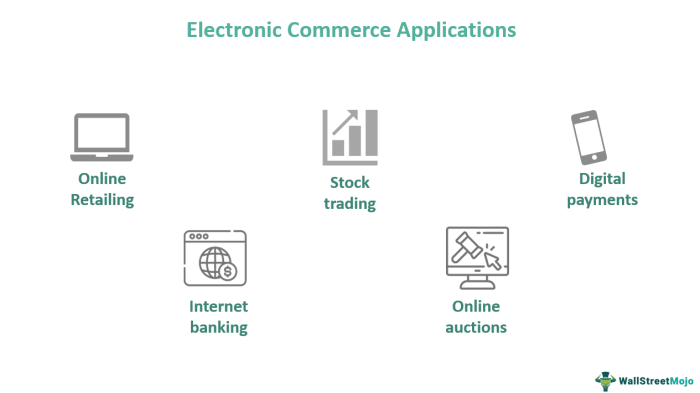E-commerce Legal and Regulatory Aspects

Navigating the legal landscape of e-commerce is crucial for success. Understanding and adhering to relevant regulations not only protects your business from potential liabilities but also fosters trust with customers and ensures long-term sustainability. This section Artikels key legal considerations for e-commerce businesses, focusing on data privacy, consumer protection, and tax compliance, as well as the impact of international trade regulations.
Data Privacy Regulations
E-commerce businesses collect vast amounts of customer data, making compliance with data privacy regulations paramount. Failure to comply can result in hefty fines and reputational damage. Key regulations include the General Data Protection Regulation (GDPR) in Europe and the California Consumer Privacy Act (CCPA) in the United States. These laws grant individuals rights regarding their personal data, including the right to access, correct, and delete their information.
Businesses must implement robust data security measures, obtain explicit consent for data collection, and provide transparent privacy policies. For example, a company should clearly Artikel what data is collected, how it is used, and with whom it is shared in its privacy policy, readily accessible on its website. Regular data protection impact assessments (DPIAs) are recommended to proactively identify and mitigate potential risks.
Consumer Protection Laws
Consumer protection laws aim to safeguard consumers from unfair or deceptive business practices. These laws often dictate requirements for product descriptions, pricing, returns, and warranties. For instance, the Magnuson-Moss Warranty Act in the US mandates specific disclosures regarding warranties offered on products. Similarly, many jurisdictions have regulations concerning online advertising, prohibiting false or misleading claims. E-commerce businesses must ensure their marketing materials accurately reflect their products and services and avoid making unsubstantiated claims.
Clear and accessible terms and conditions, outlining return policies, shipping information, and dispute resolution mechanisms, are essential for building consumer trust and avoiding legal issues.
Tax Compliance
Tax regulations for e-commerce businesses vary significantly depending on location and the type of goods or services sold. Businesses must determine their tax obligations based on their physical presence (nexus) in different jurisdictions and comply with sales tax, VAT (Value Added Tax), and other relevant taxes. For example, businesses selling goods online in the US must collect and remit sales tax in states where they have a physical presence or exceed a certain sales threshold.
Accurate sales tax calculation and remittance are crucial to avoid penalties and legal disputes. Utilizing tax software or consulting with tax professionals can assist businesses in ensuring compliance with complex tax regulations across multiple jurisdictions.
International Trade Regulations
Expanding e-commerce operations internationally introduces additional legal complexities. Businesses must comply with import/export regulations, customs duties, and trade agreements relevant to the countries they operate in. For instance, businesses exporting goods to the European Union must comply with the EU’s customs regulations, including providing necessary documentation and paying relevant duties. Understanding and adhering to these regulations is vital for avoiding delays, penalties, and legal repercussions.
Working with customs brokers and international trade specialists can help businesses navigate these complexities effectively. Furthermore, understanding and adhering to intellectual property laws in different jurisdictions is crucial for protecting trademarks and copyrights in international markets.
The Future of E-commerce

E-commerce is rapidly evolving, driven by technological advancements and shifting consumer expectations. The integration of artificial intelligence, augmented and virtual reality, and other emerging technologies is poised to revolutionize the online shopping experience, creating a more personalized, immersive, and efficient marketplace. This section explores the key technological advancements shaping the future of e-commerce and identifies several significant trends likely to define the industry in the years to come.
Artificial Intelligence and Machine Learning in E-commerce
AI and ML are already significantly impacting e-commerce, and their influence will only grow. AI-powered recommendation engines personalize product suggestions, increasing sales conversion rates. Machine learning algorithms optimize pricing strategies, predict demand, and improve inventory management, leading to reduced costs and increased profitability. For example, Amazon’s recommendation system, fueled by AI and ML, is a prime example of how these technologies drive sales by suggesting relevant products to individual users based on their browsing and purchase history.
Furthermore, AI-powered chatbots provide instant customer support, answering queries and resolving issues efficiently, leading to enhanced customer satisfaction and reduced operational costs.
Augmented and Virtual Reality in E-commerce
Augmented reality (AR) and virtual reality (VR) offer transformative potential for enhancing the customer experience. AR overlays digital information onto the real world, allowing customers to “try on” clothes or visualize furniture in their homes before purchasing. Imagine using an AR app to see how a new sofa would look in your living room, or trying on different shades of lipstick virtually before buying.
This immersive experience reduces purchase uncertainty and increases customer confidence. VR, on the other hand, creates fully immersive virtual environments, allowing customers to explore online stores and interact with products in a three-dimensional space. This technology could revolutionize online shopping for products like clothing, furniture, and even cars, providing a far more engaging and realistic experience than traditional e-commerce platforms.
For instance, a car manufacturer could allow potential buyers to virtually test drive a car in a realistic simulated environment, complete with interactive elements and realistic sounds.
Future Trends in E-commerce
The e-commerce landscape is dynamic, and several trends are likely to shape its future.
The following points represent key areas of anticipated growth and development:
- Personalized Shopping Experiences: Hyper-personalization, driven by AI and data analytics, will become increasingly prevalent, tailoring product recommendations, marketing messages, and even the entire shopping journey to individual customer preferences.
- Voice Commerce: The increasing adoption of smart speakers and voice assistants will fuel the growth of voice commerce, enabling customers to shop using voice commands, making online shopping even more convenient.
- Social Commerce: The integration of e-commerce platforms with social media networks will continue to grow, allowing customers to discover and purchase products directly through their favorite social media channels. This trend fosters community and enhances brand engagement.
- Mobile-First Approach: Mobile devices will remain the primary channel for online shopping, necessitating optimized mobile experiences and seamless mobile payment options. E-commerce businesses must prioritize mobile usability and design.
- Sustainable and Ethical E-commerce: Consumers are increasingly demanding transparency and ethical practices from businesses. This trend will drive the adoption of sustainable packaging, ethical sourcing, and environmentally friendly delivery methods.
- The Metaverse and Web3 Integration: The emergence of the metaverse and Web3 technologies presents new opportunities for e-commerce businesses to create immersive shopping experiences and engage with customers in novel ways, utilizing blockchain technology for secure transactions and digital ownership of virtual goods.